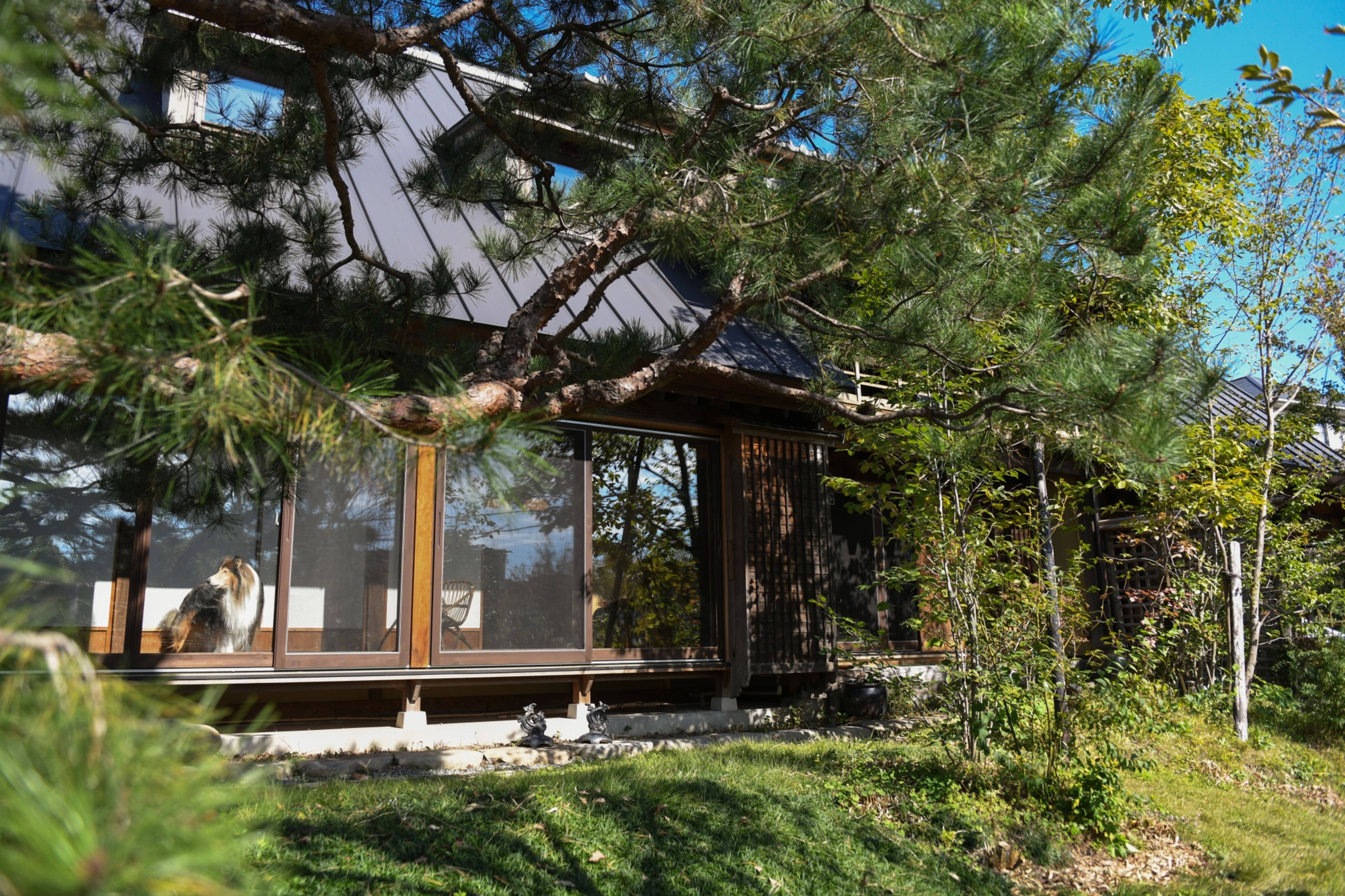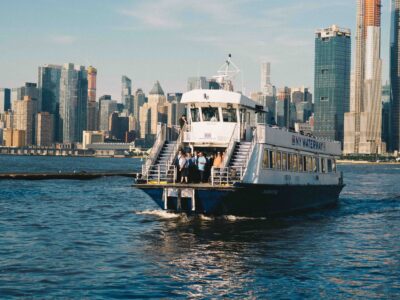(Bloomberg) —
Takumi Osawa kneels on the narrow balcony of a wooden house outside Tokyo and describes how, 140 years ago, workers would have hoisted baskets of mulberry leaves to the second floor to feed silkworms. When they ate, it sounded like rain.
Known in Japan as minka, these locally crafted structures with characteristic pitched roofs were built for hundreds of years to accommodate farmers, artisans and merchants. This one was originally constructed in 1879 and housed a family on the first floor who tended silkworms on the second and third. Minka are typically designed like an interlocking puzzle, without nails or screws, which allowed Osawa and a team of craftsmen to take the building apart, move it about 90 kilometers (56 miles) east and reassemble it closer to Tokyo, where a couple now live in it.
The number of empty homes in Japan is rising as the population shrinks and younger generations gravitate toward the city. Government data suggests as many as 8 million houses, many built during a post-World War II construction boom that lasted into the 1980s, now lie unoccupied.
In the mountains of western and northern Honshu, Japan’s main island, abandoned minka dot rural roads and out-of-the-way villages. It takes only a few winters for the roofs to cave in due to heavy snowfall, making them targets for demolition. So, in 1997, Osawa set up an organization to find, relocate and restore them before they become uninhabitable.
Osawa’s efforts are motivated by a desire to preserve Japan’s heritage architecture, with its focus on high-quality materials sourced locally, crafted by hand, and built to be functional, adaptable and ultimately recyclable. But they also place him within a global movement of progressive architects and urban planners who want to change the way we view the purpose and lifecycle of buildings, from design to demolition. And in the ethos of the minka, they see a historical blueprint for a sustainable future.
“The most wonderful thing about Japanese wooden buildings is that they can be taken apart,” says Osawa. “If we disassemble a building carefully, we can rebuild the exact the same thing, producing little waste.”
As the world careens toward greater climate instability, driven partly by the depletion of the world’s forests, there has never been a greater urgency to reform the building and construction sector. The built environment generates about 40% of planet-warming carbon emissions and the global building floor area is expected to double by 2060, according to Architecture 2030, a climate-centered nonprofit.
While about 27% of emissions from the built environment are operational — produced by processes such as cooling, heating or illumination — the rest are embodied in the structures through the extraction, manufacturing and transport of building materials.
Extending the life of existing structures, making them more efficient and reusing materials when properties are torn down offers one of the clearest paths for decarbonizing a sector that single-handedly threatens efforts to keep global warming within the 2C limit set in the 2015 Paris Agreement. Play Video
Architects have been refurbishing legacy buildings and salvaging expensive materials like stone or marble for millennia, but the urgency of the climate crisis is transforming what were once ad hoc and opportunistic efforts into a movement that’s seeking to embed the principle of reuse into every stage of the cycle — and to scale it up.
That means mapping the treasure trove of materials already woven into the fabric of our cities — and doing it across country and continent — to create an urban database that facilitates sustainable building. It also means designing new builds to double as resource banks so they can, like Osawa’s minka, be readily deconstructed and transformed into something new, over and over. It’s the circular economy writ large.
Japan’s minka are an “exemplar of what we need to do with all buildings moving forward, because we are running out of certain resources,” says Duncan Baker-Brown, a UK-based architect and author of The Re-Use Atlas. “I call it mining the anthropocene: we’ve got to learn to rework what we’ve already got.”
The efforts of architects like Osawa and Baker-Brown could finally get a boost as governments look for new ways to meet ambitious emissions targets. The built environment emerged as a focus at UN-sponsored climate talks last year and was on the agenda again at this month’s COP27 summit in Sharm el-Sheikh. But historically, urban regeneration projects have tended to be one-off developments, tailored to a specific large-scale building or neglected neighborhood — and the primary aim is usually to revitalize the local economy.
As climate startups enter the property development space armed with technology to digitally catalogue the infrastructure of entire buildings down to individual ceiling tiles and wash basins, they’re pushing a more holistic, systematic and scaleable approach.
Dutch bank ABN AMRO Group NV’s glass-walled Circl building in Amsterdam’s Zuidas district embodies the new thinking. Larch beams that support its pavilion are bolted together instead of glued so they can one day be taken apart. They were purposely left slightly longer than needed, making them easier to repurpose for a new building. Conference rooms where employees hold meetings are sectioned off by banks of window frames harvested from a former office of the health technology company Philips.
The Circl also has what’s known as a 3D “materials passport,” which describes the components of the building, how it was assembled and how it can eventually be taken apart. That helps document the value that’s stored in the structure’s fabric and secure it for the future.
“The perceived value of used products is lower, which can be seen as a barrier for the transition to a circular economy,” Jarco de Swart, a spokesperson for ABN AMRO, says in an email.
How buildings are valued over time contributes directly to their lifecycle. In many countries, businesses are incentivized to depreciate buildings quickly down to zero because that can carry tax benefits. There’s much more incentive to extend the life of buildings and the materials they embody when there’s a way to price in the environmental cost of using carbon-heavy processes or raw inputs that need to be mined, quarried or logged.
In Europe, evolving regulations are beginning to do just that. France’s RE2020 regulations limit embodied carbon in new buildings. In London, there’s a push from the mayor’s office for developers to show how they’ll minimize emissions from building operations and over a structure’s lifecycle.
But it’s the Netherlands that’s emerging as a trailblazer when it comes to more sustainable building. It’s committed to achieving a zero-waste economy by 2050 and aims to halve the use of raw materials by the end of the decade.
The shift is leading to a “refurbishment wave” in Europe, according to Clodagh Cant, a sustainability consultant with Longevity Partners, which advises clients like the hotel chain Marriot International on how to reduce the climate impact of their buildings. “We’re seeing at least 60% emission reductions in terms of embodied carbon when refurbishing over building new.”
Even in the US, renovations have overtaken new construction for the first time in 20 years.
That’s created new opportunities for climate consultants like Metabolic, which helps developers and governments quantify embodied emissions. The Dutch consultancy models the type and quantity of materials that will become available as old buildings are scheduled for renovation or demolition and predicts where they might best be used in new projects. Those are the types of calculations companies, municipalities and governments will increasingly need to make as they look to track emissions reductions.
When authorities in the US city of Philadelphia wanted to understand the climate impact of plans to renovate or demolish 570 buildings, they called on Metabolic. Its analysis found that the equivalent of more than 14,500 tons of carbon dioxide emissions could be avoided if the city took the buildings apart and recovered everything from handrails to ventilation systems. By salvaging and storing more than 13 tons of materials for future construction, authorities could also save at least $48.5 million compared to buying similar supplies new.
When the consultant expanded that approach to look at the three Dutch provinces of Groningen, Drenthe and Friesland, it determined more than 2 million tons of second-hand material worth about €136 million ($140 million) would become available as a result of demolitions through 2030. The Netherlands already downcycles about 88% of its 7 million tons of construction and demolition waste each year into things like roads, reusing materials that have already traveled through supply chains to avoid additional emissions. Upcycling preserves more value, however, and potentially extends the life of materials even further.
“A wooden window frame is worth so much more than broken glass and wood chips,” Merlijn Blok, a consultant with Metabolic, wrote in a blog post last year.
Though firms like Metabolic and Longevity already offer technology and strategies that could allow both developers and governments to scale up efforts to track and evaluate materials for reuse, efforts remain more ad hoc in countries where building codes fail to incentivize renovation.
In New York City, builders and architects are unearthing gems from rooftops and forgotten warehouses and using the history of the materials themselves to generate value.
Tri-Lox, a Greenpoint-based wood supplier and fabrication practice, reclaims old-growth timber from water towers that are being retired and uses the materials as interiors and architectural elements for clients like Shake Shack and Vice Media Inc. For Alexander Bender, who started the business with a group of childhood friends from Minneapolis more than a decade ago, using sustainably harvested wood unifies both the aesthetic and environmental components of his design philosophy.
That sensibility was on display at Tri-Lox’s warehouse, a red brick building next to an auto body shop, where the sound system pumped out hip hop and table saws whined. Straight-grained redwood with a dark earthy patina recovered from a retired tank lay stacked in one corner, drying.
“Mass timber is the future of architecture: it’s better from a carbon economy perspective and it’s faster to construct,” says Bender. “It presents an aesthetic that people want. Biophilic design — this is the concept of having spaces feel like natural spaces — taps into our innate relationship with nature and is a really powerful thing.”
If there’s a connective tissue that links the individual efforts of people like Bender and Osawa to larger decarbonization strategies being developed by firms like Metabolic and Longevity, it’s a core acknowledgement that the economic model that makes it cheaper to demolish a structure and dump the materials needs to change.
In Japan, where the government has committed to slashing emissions 46% by 2030 from 2013 levels, it’s not clear there’s a concerted effort to survey and salvage abandoned homes or aging infrastructure. Although the Environment Ministry recently began promoting the use of old timber for home construction and furniture, a spokesperson said it so far isn’t subsidizing or incentivizing reuse.
That’s despite the fact that hardwood beams from minka are often salvageable long after the structure has become uninhabitable and uneconomic to save, says Nils Wetterlind. His Heritage Homes Japan specializes in relocating and restoring wooden farm buildings from the mountains of western Honshu as well as traditional townhouses from Kyoto, but Wetterlind has also reclaimed quality timber from homes in Indonesia, Thailand and his native Sweden.
“Japan is sitting on possibly the largest bank of ancient hardwood in the world,” he says.
That means folks like Wetterlind and Osawa are on their own. Over the years, they’ve built extensive word-of-mouth networks to identify buildings that have been abandoned, are up for sale or are scheduled for demolition.
In early November, Osawa’s Japan Minka Revival Association website, which he refers to as a “minka bank,” listed about three dozen wooden buildings for sale. The structures listed were built during the mid-Edo, Meiji, Taisho and early Showa periods, a span of about 180 years ending in 1960.
When a buyer is found, Osawa works with local carpenter associations to “unwind” the building by numbering each wooden component before dismantling it, beam by beam, and rebuilding it in a new location, often with contemporary comforts and updated amenities. Because each minka is unique, adapted for a specific climate, function and even to accommodate the natural curves of the hardwood timber that forms its skeleton, relocation can take several years and typically involves dozens of workers.
On a recent visit, the silkworm house outside Tokyo was an oasis of calm surrounded by smaller homes and multi-story apartment buildings with laundry drying from balconies in the late autumn sun. A highway laces the horizon a couple of hundred meters away and signs for a golf shop and a Mazda dealership are in view from the second story.
Despite his efforts to revive demand, Osawa estimates that several hundred minka around Japan are in danger of being lost, partly because they’re perceived as lacking modern conveniences but also because the cost of relocating and updating one can be significantly higher than building new.
So he’s teamed up with Brent Potter, an American, to start KyotoTrove, which aims to supply overseas architects and builders with everything from vintage paper sliding doors to complete residences. Ironically, Osawa thinks exporting a few minka may renew domestic interest and inspire a broader shift in attitudes toward architectural heritage and renewal.
“Modern buildings are most beautiful when they’re first completed” but they deteriorate over time, he says. “On the other hand, the older minka get, the more beautiful they become.”
(Updates with Quicktake video, changes terminal headline)
To contact the authors of this story:
Aaron Clark in Tokyo at aclark27@bloomberg.net
Erica Yokoyama in Tokyo at eyokoyama12@bloomberg.net
© 2022 Bloomberg L.P.





